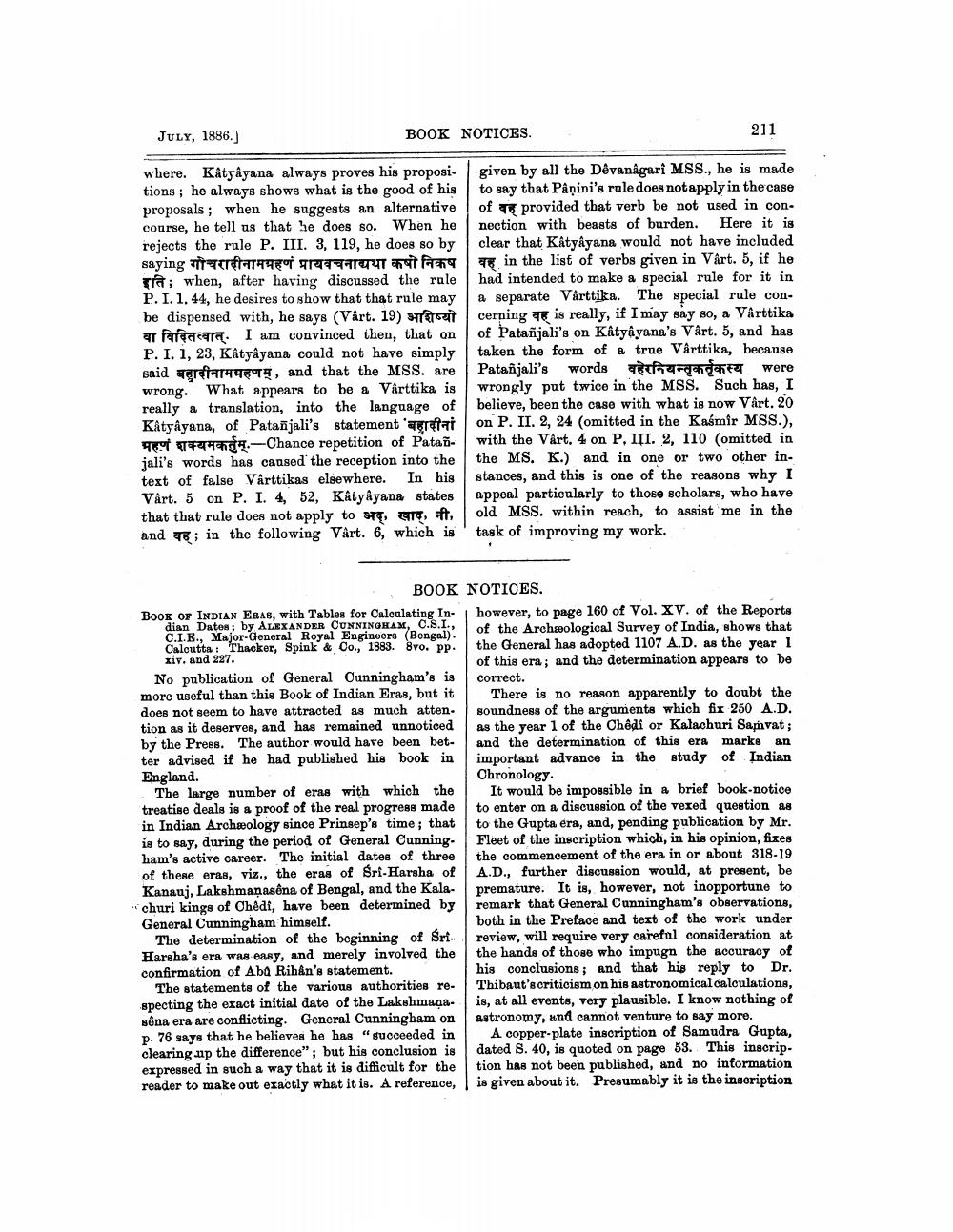________________
BOOK NOTICES.
JULY, 1886.]
where. Kâtyâyana always proves his propositions; he always shows what is the good of his proposals; when he suggests an alternative course, he tell us that he does so. When he rejects the rule P. III. 3, 119, he does so by saying गोचरादीनामग्रहणं प्रायवचनाद्यथा कषो निकष
wrong.
; when, after having discussed the rule P. I. 1. 44, he desires to show that that rule may be dispensed with, he says (Vârt. 19) si ar faracara. I am convinced then, that on P. I. 1, 23, Kâtyâyana could not have simply Baid बहुादीनामग्रहणम्, and that the Mare What appears to be a Vârttika is really a translation, into the language of Katyayana, of Patanjali's statement 'agrai महणं शक्यमकर्तुम्. – Chance repetition of Patañ jali's words has caused the reception into the text of false Vârttikas elsewhere. In his Vårt. 5 on P. I. 4, 52, Kâtyâyana states that that rule does not apply to अद्, खाद्, नी, and in the following Vârt. 6, which is
BOOK NOTICES.
BOOK OF INDIAN ERAS, with Tables for Calculating Indian Datos; by ALEXANDER CUNNINGHAM, C.S.I., C.I.E., Major-General Royal Engineers (Bengal). Calcutta: Thacker, Spink & Co., 1883. 8vo. pp. xiv. and 227.
No publication of General Cunningham's is more useful than this Book of Indian Eras, but it does not seem to have attracted as much attention as it deserves, and has remained unnoticed by the Press. The author would have been better advised if he had published his book in England.
The large number of eras with which the treatise deals is a proof of the real progress made in Indian Archæology since Prinsep's time; that is to say, during the period of General Cunningham's active career. The initial dates of three of these eras, viz., the eras of Sri-Harsha of Kanauj, Lakshmanasêna of Bengal, and the Kalachuri kings of Chêdî, have been determined by General Cunningham himself.
The determination of the beginning of Sri Harsha's era was easy, and merely involved the confirmation of Aba Rihan's statement.
The statements of the various authorities respecting the exact initial date of the Lakshmana. sêna era are conflicting. General Cunningham on p. 76 says that he believes he has "succeeded in clearing up the difference"; but his conclusion is expressed in such a way that it is difficult for the reader to make out exactly what it is. A reference,
211
given by all the Dêvanâgari MSS., he is made to say that Pânini's rule does not apply in the case of provided that verb be not used in connection with beasts of burden. Here it is clear that Kâtyâyana would not have included वह in the list of verbs given in Vart. 5, if he had intended to make a special rule for it in a separate Vârttika. The special rule concerning is really, if I may say so, a Vârttika of Patanjali's on Kâtyâyana's Vårt. 5, and has taken the form of a true Vârttika, because Patañjali's words वहेरनियन्तृकर्तृकस्य were wrongly put twice in the MSS. Such has, I believe, been the case with what is now Vârt. 20 on P. II. 2, 24 (omitted in the Kasmir MSS.), with the Vårt. 4 on P. III. 2, 110 (omitted in the MS. K.) and in one or two other instances, and this is one of the reasons why I appeal particularly to those scholars, who have old MSS. within reach, to assist me in the task of improving my work.
however, to page 160 of Vol. XV. of the Reports of the Archæological Survey of India, shows that the General has adopted 1107 A.D. as the year I of this era; and the determination appears to be
correct.
There is no reason apparently to doubt the soundness of the arguments which fix 250 A.D. as the year 1 of the Chêdi or Kalachuri Samvat; and the determination of this era marks an important advance in the study of Indian Chronology.
It would be impossible in a brief book-notice to enter on a discussion of the vexed question as to the Gupta era, and, pending publication by Mr. Fleet of the inscription which, in his opinion, fixes the commencement of the era in or about 318-19 A.D., further discussion would, at present, be premature. It is, however, not inopportune to remark that General Cunningham's observations, both in the Preface and text of the work under review, will require very careful consideration at the hands of those who impugn the accuracy of his conclusions; and that his reply to Dr. Thibaut's criticism on his astronomical calculations, is, at all events, very plausible. I know nothing of astronomy, and cannot venture to say more.
A copper-plate inscription of Samudra Gupta, dated S. 40, is quoted on page 53. This inscription has not been published, and no information is given about it. Presumably it is the inscription




